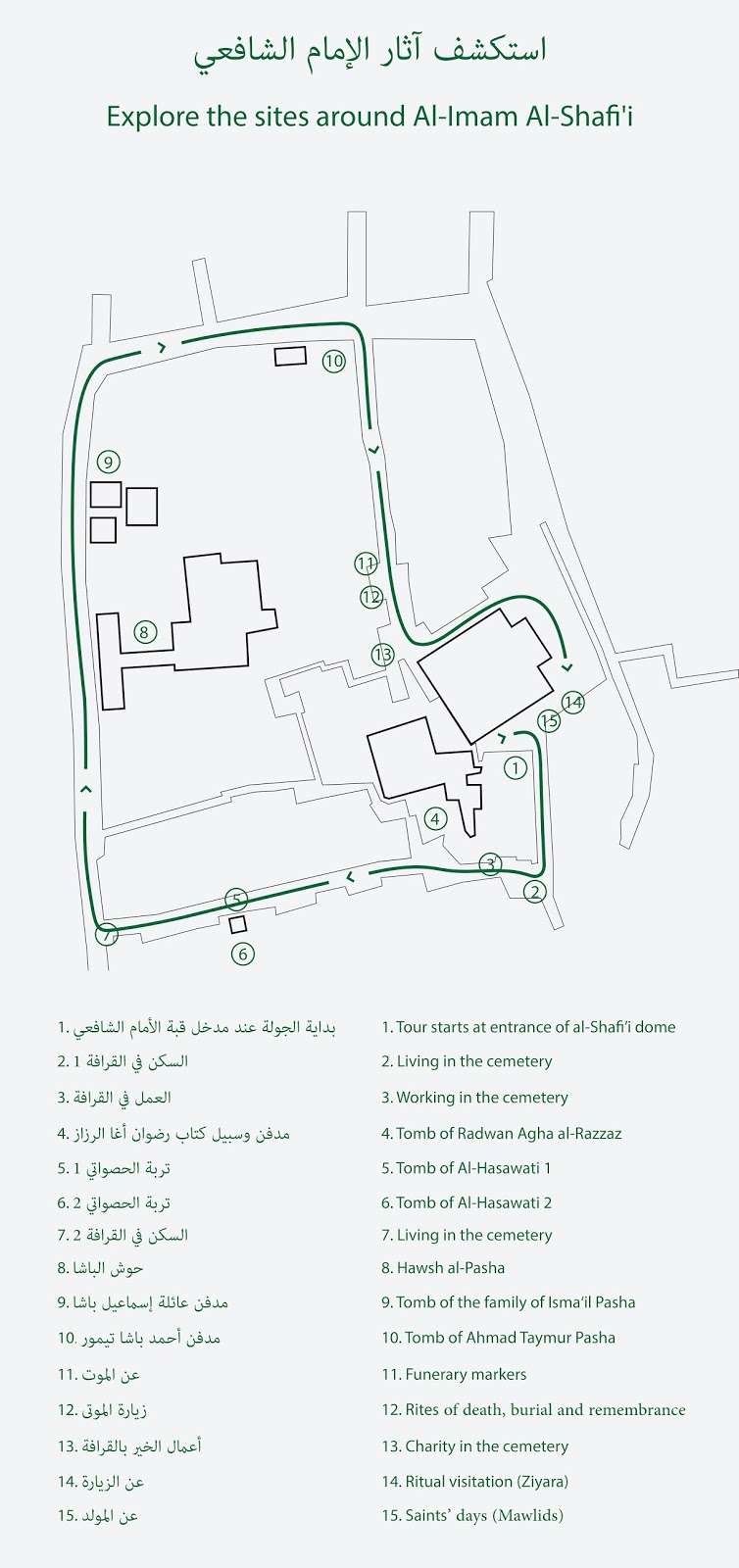بداية الجولة / Tour Start
هذه الجولة تتيح للزائر الفرصة التجول بالآثار والتعرف على تاريخها وتاريخ القرافة بدون مرشد. الجولة عبارة عن محطات بكل محطة جدارية بها رابط. لمزيد من المعلومات صور رمز الرابط بتليفونك المحمول.
مدة الجولة: 30-45 دقيقة
تاريخ جبانات القاهرة
أعلم أن لأهل مدينة مصر ولأهل القاهره عدة مقابر ، وهى القرافة: فما كان منها فى سفح الجبل يقال له القرافة الصغرى، وما كان منها فى شرق مصر بجوار المساكن يقال له القرافة الكبرى. وفى القرافة الكبرى كانت مدافن أموات المسلمين منذ افتتحت أرض مصر، واختط العرب مدينة الفسطاط، ولم يكن لهم مقبرة سواها.فلما قدم القائد جوهر ، من قبل المغز لدين الله، وبنى القاهرة، وسكنها الخلفاء، اتخذوا بها تربة، عرفت بتربة الزعفران، قبروا فيها أمواتهم، ودفن رعيتهم من مات منهم فى القرافة. إلى أن اختطت الحارات خارج باب زويلة، فقبر سكانها موتاهم خارج باب زويلة مما يلى الجامع، فيما بين جامع الصالح وقلعة الجبل، وكثرت المقابر بها عند حدوث الشدة العظمى أيام الخليفة المستنصر
ثم لما مات أمير الجيوش بدر الجمالى، دفن خارج باب النصر, فاتخذ الناس هنالك مقابر موتاهم، وكثرت مقابر أهل الحسينية في هذه الجهة. ثم دفن الناس الأموات خارج القاهرة، في الوضع الذى عرف بميدان القبق، فيما بين قلعة الجبل وقبة النصر، وبنوا هناك الترب الجبلية، ودفن الناس أيضا خارج القاهرة فيما بين باب الفتوح والخندق.
تقي الدين المقريزي مؤرخ من العصر المملوكي
⇩⇩ مسار الجولة
This itinerary is designed for the independent traveler to visit the surrounding sites and get to know the history of the cemetery of al-Qarafa. Each station contains a mural with a link to more information.Take a picture of the QR code with your mobile phone to find out more.
Duration of tour: 30-45 minutes
Duration of tour: 30-45 minutes
History of Cairo’s cemeteries
“The people of Misr and al-Qahira have several burial grounds, (the main one) being al-Qarafa. The section to the foot of the (Muqattam) mountain is called al-Qarafa al-Sughra while the part to the east of Misr (al-Fustat) next to the houses is called al-Qarafa al-Kubra and was the burial ground for the Muslim dead since the conquest of Egypt and the founding of the city of al-Fustat by the Arabs who only buried their dead there ... (The Fatimids then established within their palace in the city of al-Qahira) Turbat al-Za’faran where they buried their dead, while the populace continued to bury their dead in al-Qarafa. Then the haras (residential alleys) were established outside Bab Zuwayla and their inhabitants buried their dead outside Bab Zuwayla in the area between the mosque of al-Salih (Tala’i’) and al-Jabal ... Then when Amír al-Juyush, Badr al-Jamali died, he was buried outside Bab al-Nasr and people, especially the inhabitants of al-Husayniyya started to bury their dead there. The people then started to bury their dead outside al-Qahira in the area then known as Maydan al-Qabaq between al-Jabal and Qubbat al-Nasr, where they built lofty tombs. They also buried their dead outside al-Qáhira in the area between Bab al-Futuh and al-Khandaq”
Taqiyy al-Din al-Maqrizi (15th century historian)

